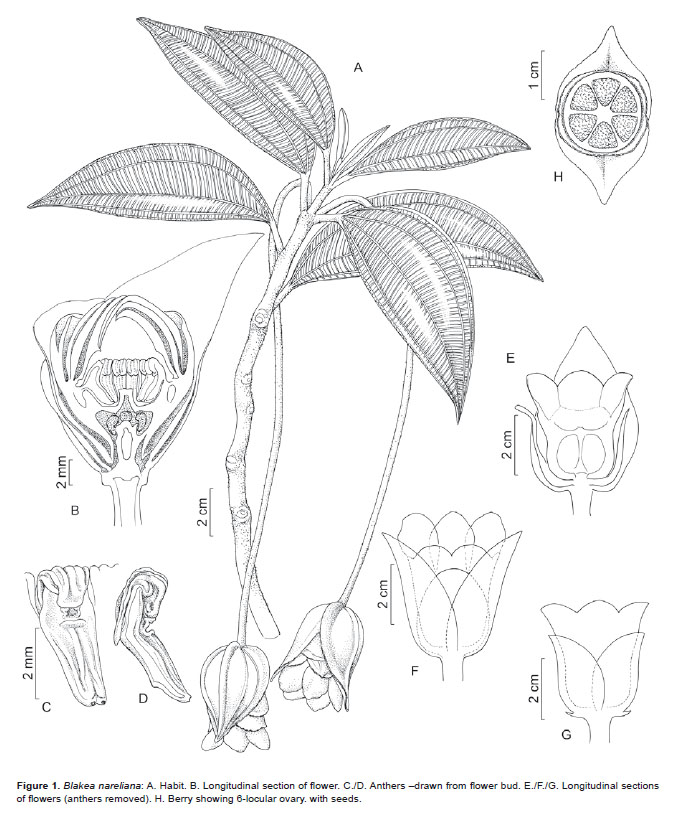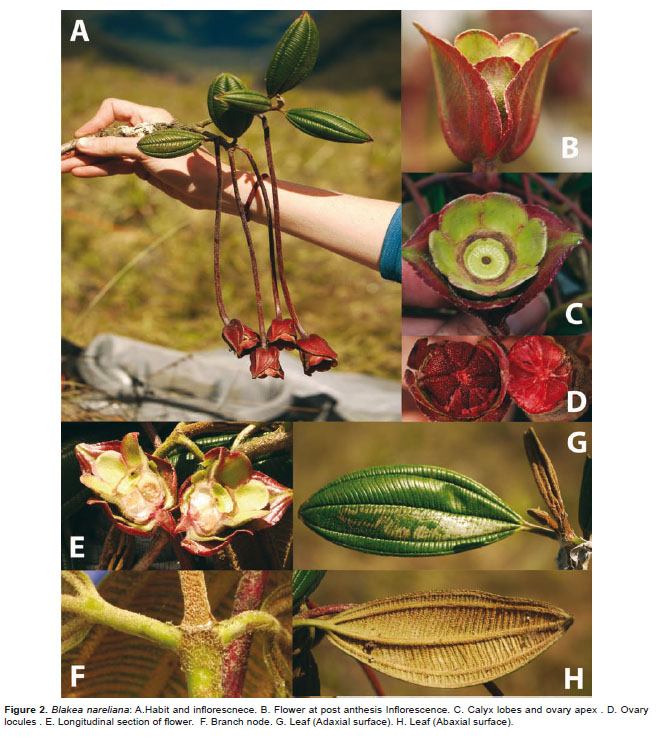Services on Demand
Journal
Article
Indicators
-
 Cited by SciELO
Cited by SciELO
Related links
-
 Similars in
SciELO
Similars in
SciELO  uBio
uBio
Share
Revista Peruana de Biología
On-line version ISSN 1727-9933
Rev. peru biol. vol.20 no.2 Lima Aug. 2013
TRABAJOS ORIGINALES
Blakea nareliana (Melastomataceae), a new species from the upper Huallaga in Northern Peru
Blakea nareliana (Melastomataceae), una nueva especie del Alto Huallaga, en el norte del Perú
Rainer W. Bussmann
William L. Brown Center, Missouri Botanical Garden, PO Box 299, Saint Louis, MO 63166-0299, USA.
Email Rainer Bussmann: rainer.bussmann@mobot.org
Abstract
A new Peruvian species of Blakea (Melastomataceae) is described. Blakea nareliana is a small tree, endemic to the cloud forest zone in the northern Andean Huallaga area of Peru. This region is highly diverse and under-collected due to difficult access. Currently the new species is only known from one population at the type locality. However, extensive collections in the wider region have led to the discovery of many previously unknown populations of other rare Melastomataceae. It is to be hoped that future collecting efforts in the region will yield more material of Blakea nareliana.
Keywords: Peru; endemism; montane forest; cloudforest; Blakeeae
Resumen
Se describe una especie nueva peruana de Blakea (Melastomataceae). Blakea nareliana es un pequeño árbol, endémico de la zona de bosque nublado en la zona del Huallaga en los Andes del norte del Perú. Esta región es conocida por su gran diversidad, pero también ha sido poco estudiada debido a su difícil acceso. Actualmente, la nueva especie sólo se conoce de una población en la localidad tipo. Sin embargo, expediciones que hemos realizado en toda la extensión de la región han permitido encontrar nuevas poblaciones de Melastomataceae consideradas anteriormente muy raras, y es de esperar que más material de Blakea nareliana se pueda encontrar en un futuro próximo.
Palabras clave: Perú, endemismo, bosque montano, bosque nublado, Blakeeae
Introduction
As historically circumscribed, the Blakeeae (Melastomataceae) include two genera, Blakea P. Browne and Topobea Aubl, both characterized by baccate fruits, axillary flowers with two pairs of decussate bracts, and ovoid to pyramidal seeds. Blakea is characterized by laterally compressed, short, obtuse, anthers with two apical pores (Wurdack, 1980). According to Almeda (1990) these differences seemed to be, however, insufficient for separating the two genera in Central America, although they seemed to be effective in South America (Cotton & Matetzki 2003). Phylogenetic analyses of the Blakeeae (Penneys & Judd 2011, 2013a) have now demonstrated the non-monophyly of the former genera, thus Topobea has been transferred to Blakea (Penneys & Judd 2013b). The Catalogue of Flowering plants and Gymnosperms of Peru (Brako & Zarucchi 1993) lists 18 species of Blakea s.l. Unfortunately the sampling for many species is poor.
Northern Peru and southern Ecuador are particularly rich in endemic species. The Huancabamba depression, the lowest section of the central Andean Cordillera, permits an exchange between the floras and faunas of the Amazon basin and the Pacific lowlands. This greatly contributes to its richness in endemic species (Barthlott et al. 1996, Borchsenius 1997, Valencia et al. 2000, Weigend 2002, Cotton et al. 2004; Bussmann 2005, 2006; Bussmann et al. 2010, Bussmann & Paniagua in press), which are well exemplified by the Melastomataceae. The new Blakea described here, following a phenetic/morphological species concept, adds yet another species of Melastomataceae to the rich flora of the region.
Blakea nareliana Bussmann sp. nov.
Haec species Blakeae penduliflorae Almeda similis, foliis menoribus lanceolatus vs. ovatus, pedicelli longissimi (21−32 vs. 3−6 cm), bracteae purpurea, longioribus y amplioribus (40−50 x 40−50mm vs. 17−25 x 12−18mm), basis filamentis conatus, styli longioribus (25−35 vs. 17−18mm) differt.
Type: PERU. Region Amazonas, Provincia Chachapoyas, Districto Leymebamba. Cloud forest along trail from La Esperanza to Laguna de Los Condores. Disturbed cloud forest dominated by Weinmannia and Polylepis. 06°4924S 077°4236W, 2900−3250 m. 30 June 2010. A.E. Glenn, R.W. Bussmann, C. Vega & G. Chait 524 (holotype HAO!, isotypes MO!, NY!).
Tree 4−6 m tall. Young stems and abaxial foliar surfaces with well developed, 0.2−1 mm long, wooly, dendritic, rusty brown hairs with well developed axis and moderate number of terete short to moderately long arms (Wurdack 1980, indumentum type 26), persistent; Mature leaves of each pair equal in size, 3.5−5.5 x (8)−11.5−(13) cm, elliptic-lanceolate, cuspidate apically and acute to obtuse basally, 5-nerved, secondary lateral veins 1−2 mm distant chartaceous to coriaceous, entire, with broadly revolute margins, brownish green and glabrous adaxially, pale rusty-brown abaxially; petioles 18−30 (35) mm long and 1.5−2.5 mm diameter; petiole length to lamina length 1:(2.2)−2.5−(4); lamina length to width (1.7)−2−(3.9):1. Flowers 6-merous, pendent, 1−2−(4) per axil; peduncles 21−32 cm long, essentially glabrous. Floral bracts elliptic to elliptic-ovate, entire, purplishred, essentially glabrous, obtuse to rounded apically, free; outer bracts 35−40 x 40−45 mm, with 5−7 mm long, 2−3 mm wide apex; inner bracts 20−25 x 15−25 mm with 2 mm long, 1 mm wide apex, with prominent venation. Hypanthia (at anthesis) 2−3 mm long to the torus and 4−5 mm wide, campanulate, glabrous. Calyx lobes 10−12 mm long and 8−10 mm wide basally between sinuses, persistent and mostly erect to somewhat spreading on mature hypanthia, ovate, entire, sparsely hairy, smooth hairs distributed throughout. Petals 20−25 x 25−35 mm, obovate, rounded apically, yellowish-green, entire, fleshy, glabrous, more or less concave and imbricate when almost fully expanded. No completely expanded flowers were found. Stamens isomorphic, free; filaments 3.5−4 x 1.5 mm, fused at the base, forming a 330 degree circle around style, glabrous, ligulate; anthers at anthesis 2−3.5 mm long and 1.5−2 mm wide, glabrous, evenly dark purple, laterally compressed, with 2 truncate or somewhat dorsally inclined circular pores; connective thickened dorsally near the point of filament insertion and dilated basally into a short deflexed caudiform appendage. Style 25−35mm long, straight, glabrous, conspicuously exserted; stigma truncate. Ovary inferior, 6-locular. Mature berries 1.5−2cm long, 1.5 cm wide, oval, bright red. Seeds 1−1.5 mm long, bright red, clavate to narrowly pyriform, smooth.
Blakea nareliana most closely resembles Blakea penduliflora Almeda described from Costa Rica (Almeda 1980), and could even be closely related to this species. It differs from Blakea penduliflora in having smaller, elliptic-lanceolate (vs. ellipticovate) leaves, very long peduncles (20−30 vs. 3− cm), much larger (40−50 mm vs. 25 mm long and wide), reddish-purple bracts, basally fused filaments, much longer styles (25−30 vs. 17−18mm). Also in B. penduliflora the outer floral bracts are connate basally for about 2−3 mm unlike the new species described here and the petals are green with a flush of purple basally on the adaxial surface. The floral peduncles (pedicels) are also conspicuously lenticellate but no mention is made of this in the new species so perhaps they are completely glabrous.
Additional specimens examined: PERU. Region Amazonas, Provincia Chachapoyas, Districto Leymebamba. Cloud forest at Laguna de Los Condores. Disturbed cloud forest dominated by Weinmannia and Polylepis. 06°4924S 077°4236W, 3000 m. 20 May 2012. L. Cotrina 002 (HAO!, Herbario INBIA Perú, Trujillo).
Distribution and conservation status
Known only from the type locality in the Peruvian region Amazonas, Chachapoyas province, Leymebamba district on the eastern slopes of the Northern Peruvian Andes. Blekea na
reliana was found around in the Lagunas de los Condores area, at 2900−3250 m. Individuals of Blakea nareliana were found in small groups in three areas in dense cloud forest stands near small creeks and lakes. Blakea nareliana flowers mostly in the wet season from March − May and fruits May−June.The species must be regarded as critically endangered (CR A3B2ab(i,iii,iv)) according to IUCN (2013) because it is known only from a restricted area of less than 10km2 and the entire population is outside protected areas.
Etymology
Blakea nareliana is named in honor of Narel Paniagua, for her dedication to the study and conservation of the Andean and Amazonian flora and its traditional uses.
Acknowledgements
The study was financed through funds from William L. Brown Center at Missouri Botanical Garden. We gratefully acknowledge the tireless help of Ing. Carlos Vega Ocaña, INBIAPAERU, for his constant help with the collection of material. Thanks to Barbara Alongi for the line drawings.
Literature cited
Almeda F. Blakea penduliflora (Melastomataceae): A new Green−Flowered species from Costa Rica. Brittonia 32(4): 508−511. [ Links ]
Almeda F. 1990. New species and new combinations in Blakea and Topobea (Melastomataceae), with an historical perspective on generic limits in the Tribe Blakeeae. Proc. Calif. Acad. Sci. Ser 4, 46: 299− 326. [ Links ]
Barthlott W., W. Lauer, & A. Flacke, 1996. Global distribution of species diversity in vascular plants: towards a world map of phytodiversity. − Erdkunde 50: 317−327. [ Links ]
Borchsenius F. 1997. Patterns of plant species endemism in Ecuador. − Biodiv. Conserv. 6: 379−399. [ Links ]
Brako L. & J. L. Zarucchi, (eds) 1993. Catalogue of the Flowering Plants and Gymnosperms of Peru. [ Links ] Monographs in Systematic Botany 45. Missouri Botanical Garden, Saint Louis, MO.
Bussmann R. W. & S. Lange. 1998. Expedition Rapido Acceso Cordillera Sabanilla − Inventario floristico. Loja/Quito: ECSF/INEFAN. [ Links ]
Bussmann R.W. 2005. Bosques Andinos del Sur de Ecuador − Clasificación, Regeneración y uso. Andean Forests of Southern Ecuador, classification, regeneration and use. Rev. Biol. Peruv. 12(2): 203−216. [ Links ]
Bussmann R.W. 2006. Manteniendo el balance de naturaleza y hombre: La diversidad florística andina y su importancia por la diversidad cultural − ejemplos del Norte de Perú y Sur de Ecuador. Arnaldoa 13(2): 382−397. [ Links ]
Bussmann R.W., J. Gruhn & A. Glenn. 2010. Axinaea fernando−cabiesii and A. reginae spp. nov. (Melastomataceae) from upper Amazonia of Peru, with notes on the conservation status of A. flava. Nord. J. Bot. 28: 518−522. [ Links ]
Bussmann R.W. & N. Paniagua Zambrana. Axinaea ninakurorum (Melastomataceae) −a new species from the northern Peruvian Merianeae hotspot. Arnaldoa. [ Links ]
Cotton E. & S. Matezki. 2003. Ecuadorian Novelties in Blakea and Topobea (Melastomataceae). Brittonia, 55(1): 73−81
[ Links ]Cotton, E., R.W. Bussmann, & P. Lozano. 2004. Three new Ecuadorian species of Axinaea (Melastomataceae). Nord. J. Bot. 23: 49−55. [ Links ]
IUCN Standards and Petitions Subcommittee. 2013. Guidelines for Using the IUCN RedList Categories and Criteria. Version 10. Prepared by the Standards and Petitions Subcommittee. Downloadable from http://www.iucnredlist.org/documents/RedListGuidelines.pdf
[ Links ]Penneys, D.S. & W.S. Judd. 2011. Phylogenetics and morphology in the Blakeeae (Melastomataceae). Int. J. Pl. Sci. 172: 78−106. [ Links ]
Penneys, D.S. & W.S. Judd. 2013. A revised circumscription for the Blakeeae (Melastomataceae) with associated nomenclatural adjustments. PhytoKeys 20: 17−32. [ Links ]
Valencia, R., N. Pitman, S. León−Yánez, & P.M. Jørgensen (eds). 2000. Libro Rojo de las Plantas Endemicas del Ecuador 2000. − Herbario QCA, Pontificia Universidad Católica del Ecuador, Quito. [ Links ]
Wurdack, J.J. 1980. Melastomataceae. − In: Harling, G. & Sparre, B. (eds), Flora of Ecuador 13: 1−403. [ Links ]
Wurdack, J. J. 1986. Atlas of hairs for Neotropical Melastomataceae. Smiths. Contr. Bot. 63: 1−80. [ Links ]
Presentado: 09/04/2013
Aceptado: 17/05/2013
Publicado online: 09/12/2013















